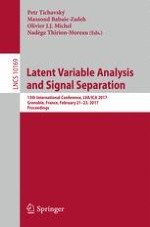2017 | Buch
Latent Variable Analysis and Signal Separation
13th International Conference, LVA/ICA 2017, Grenoble, France, February 21-23, 2017, Proceedings
herausgegeben von: Petr Tichavský, Massoud Babaie-Zadeh, Olivier J.J. Michel, Nadège Thirion-Moreau
Verlag: Springer International Publishing
Buchreihe : Lecture Notes in Computer Science
